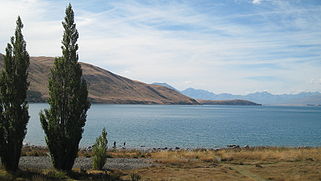|
|
 Lake
Tekapo
is located
in the centre of the
South Island
of
New Zealand lies
Lake Tekapo.
This highland lake and settlement at 710 meters (2300 feet) is in the heart
of the Mackenzie District, close to
Aoraki Mt Cook
National Park and surrounded by a vast alpine basin of golden tussock grass. Lake
Tekapo
is located
in the centre of the
South Island
of
New Zealand lies
Lake Tekapo.
This highland lake and settlement at 710 meters (2300 feet) is in the heart
of the Mackenzie District, close to
Aoraki Mt Cook
National Park and surrounded by a vast alpine basin of golden tussock grass.
Lake Tekapo is a popular tourist destination and is near the town of Tekapo
which is a full service town and offering a range of accommodation in the township. The lake's outflow into the Tekapo River is close
to the township.
Lake Tekapo is at the upper end of the Waitaki
hydroelectric scheme and as such, several dams and artificial canals are
found near its outflow, linking it with Lake Pukaki.
The name Tekapo derives from Maori words Taka
(sleeping mat) and
Po
(night). Finely ground rock in the glacial melted waters give
Lake Tekapo
a beautifully unique turquoise colour.
Lake
Tekapo's geographical and central location is protected from
rough coastal weather by the Southern Alps in the west and the
Two Thumb
Range to the east. This allows this highland
location to enjoy some of
New Zealand's highest sunshine hours and
lowest average wind speeds. Rainfall is just 575 millimeters (23 inches)
annually.
Summer or winter, snow-covered or golden yellow, the surrounding mountains
and turquoise lake make a spectacular backdrop for the Church of the Good
Shepherd.
Lake Tekapo being the base for the
Mount John University Observatory and
due to
clear atmosphere, large number of clear sky
nights, and lack of light pollution,
makes
Lake Tekapo
an ideal location to reveal an unforgettable night sky.
The township of Tekapo and Lake Tekapo are served by regular daily
bus and coach services to and from
Queenstown,
Wanaka,
Twizel,
Mt
Cook and
Christchurch.
There are no regular schedules air services to and from Lake Tekapo.
There are no passenger train or rail services from Lake Tekapo to Mt Cook,
Queenstown, Twizel, Dunedin, Invercargill, Methven, Timaru, Oamaru or
Christchurch. |
 Lake
Tekapo
is located
Lake
Tekapo
is located